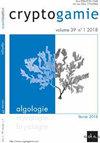Ulva L. biodiversity in the central Mediterranean Sea: cryptic species and new records
IF 1.5
4区 生物学
Q3 MARINE & FRESHWATER BIOLOGY
引用次数: 2
Abstract
ABSTRACT Ulva L. species are problematic to identify since they have cryptic morphologies with few distinctive features, as well as significant intraspecific variation. In this study, we report two new records for the Maltese islands: the heterokont benthic multicellular algae Ulva torta (Mertens) Trevisan and Ulva californica Wille, which were isolated and grown in culture from incubated natural substrata. This study includes an integrative systematics approach using both morphology and barcode sequencing of the nuclear internal transcribed spacer (ITS) region (ITS1-5.8S-ITS2), the chloroplast RUBISCO LSU (rbcL) gene and the elongation factor Tu (tufA). Subsequent phylogenetic analyses, supported the separation of these two species from other closely-related congeners that have previously been reported from the Maltese islands. RÉSUMÉ Biodiversité des Ulva L. en Méditerranée centrale: espèces cryptiques et signalements nouveaux. Certaines espèces d'Ulva L. sont difficiles à identifier car elles sont cryptiques, soit par manque de caractères distinctifs, soit en raison de variation phénotypique intraspécifique. Cette étude documente deux nouvelles espèces pour les îles maltaises: les algues multicellulaires benthiques hétérokontes Ulva torta (Mertens) Trevisan et Ulva californica Wille, qui ont été isolées et cultivées en culture à partir de substrats naturels incubés. Cette étude comprend une approche intégrative utilisant la morphologie aussi bien que le séquençage d'ADN de la région de l'espaceur transcrit interne nucléaire (ITS) (ITS1-5.8S-ITS2), du gène chloroplastique RUBISCO LSU (rbcL) et du facteur d'élongation Tu (tufA). Ces deux espèces ont été séparées de leurs proches congénères des îles maltaises grâce aux analyses phylogénétiques.地中海中部Ulva .生物多样性:隐种和新记录
Ulva L.物种的鉴定存在问题,因为它们具有几乎没有显著特征的隐形态,以及显着的种内变异。在这项研究中,我们报告了马耳他群岛的两个新记录:异源底栖多细胞藻类Ulva torta (Mertens) Trevisan和Ulva californica Wille,它们是从培养的自然基质中分离和培养的。本研究采用综合系统学方法,对核内转录间隔区(ITS - 1-5.8 s - its2)、叶绿体RUBISCO LSU (rbcL)基因和延伸因子Tu (tufA)进行形态学和条形码测序。随后的系统发育分析支持了这两个物种与之前在马耳他群岛报道的其他密切相关的同系物的分离。RÉSUMÉ生物多样性(生物多样性与生物多样性)。某些特定的个体在识别个体时遇到了困难,在识别个体时遇到了困难,在识别个体时遇到了困难,在识别个体时遇到了困难,在识别个体时遇到了困难,在识别个体时遇到了困难。ceta文件《关于马耳他人的新信息》:《关于多细胞生物的基本信息》:《关于马耳他人的多细胞生物的基本信息》:《关于马耳他人的多细胞生物的基本信息》;《关于加利福尼亚人的基本信息》;《关于马耳他人的基本信息》;《关于马耳他人的基本信息》。这个练习曲comprend一approche综合使用la morphologie也很好,le sequencage d 'ADN de la地区de l 'espaceur transcrit实习医师远离(其)(its1 - 5.8 (its2), du基因chloroplastique RUBISCO路易斯安那州立大学(rbcL)而du因素d 'elongation涂(凝灰岩)。cedeux esectrots ont samsamparacmes de leurs处理consamures nres des les maltaises graise , ceaux分析phylogsamusts。
本文章由计算机程序翻译,如有差异,请以英文原文为准。
求助全文
约1分钟内获得全文
求助全文
来源期刊

Cryptogamie Algologie
生物-海洋与淡水生物学
CiteScore
2.60
自引率
7.70%
发文量
11
审稿时长
>12 weeks
期刊介绍:
Cryptogamie is a fast-track and peer-reviewed journal of international scope publishing in English only. It accepts original papers and review articles on the taxonomy, biology and ecology of all cryptogams. An issue of Cryptogamie may be devoted to a single topic, under the responsibility of guest editor(s). All articles published in Cryptogamie are compliant with the different nomenclatural codes. A copyright assignment will be signed by the authors before publication.
Cryptogamie, Algologie accepts articles on systematics as well as ecology and evolution of any kind of algae (including Cyanobacteria).
 求助内容:
求助内容: 应助结果提醒方式:
应助结果提醒方式:


